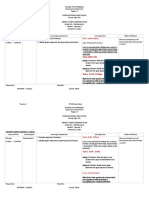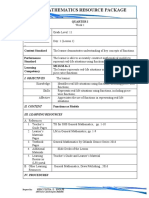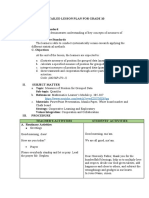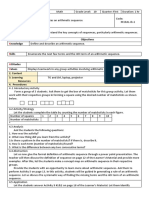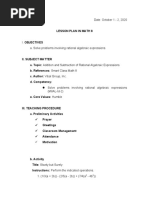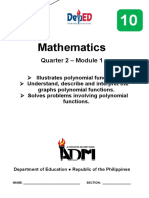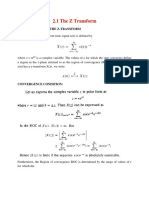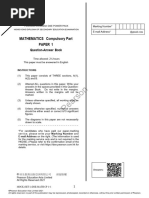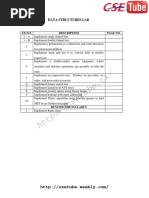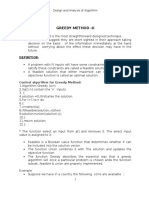Department of Education: Republic of The Philippines
Department of Education: Republic of The Philippines
Uploaded by
Euclid EuclidCopyright:
Available Formats
Department of Education: Republic of The Philippines
Department of Education: Republic of The Philippines
Uploaded by
Euclid EuclidOriginal Description:
Original Title
Copyright
Available Formats
Share this document
Did you find this document useful?
Is this content inappropriate?
Copyright:
Available Formats
Department of Education: Republic of The Philippines
Department of Education: Republic of The Philippines
Uploaded by
Euclid EuclidCopyright:
Available Formats
Republic of the Philippines
Department of Education
Region IV -A CALABARZON
SCHOOLS DIVISION OF LIPA CITY
Learning Area MATHEMATICS 10
Learning Delivery Modality Modular Distance Modality
LESSON School Fernando Air Base INHS Grade Level 10
EXEMPLAR Teacher REY R. PAMIS Learning Area Mathematics
Teaching Date Quarter First Quarter
Teaching Time No. of Days 4 Days
I. OBJECTIVES
A. Content Standards The learner demonstrates the understanding of key concepts of
sequences, polynomials and polynomial equations.
B. Performance Standards The learner is able to formulate and solve problems involving
sequences, polynomials and polynomial equations in different
disciplines through appropriate and accurate representations.
C. Learning Competencies or At the end of the lesson, the students must be able to:
Objectives 1. Factor polynomials using the different factoring methods,
2. Solve problems involving factoring,
3. Applying factoring techniques in solving real life problems.
D. Most Essential Learning Factors Polynomials
Competencies (MELC) -factor completely different types of polynomials (polynomials with
(If available, write the indicated MELC) common monomial factor, difference of two squares, sum and
difference of two cubes, perfect square trinomials and general trinomials
E. Enabling Competencies
(If available, write the attached enabling
competencies)
MATHEMATICS - 10
II. CONTENT Lesson 10: FACTORING POLYNOMIALS
III. LEARNING RESOURCES
A. References
a. Teacher’s Guide Pages
Teacher’s Guide Pages 50 - 53
b. Learner’s Material Pages
Learner’s Material Pages 56-58
c. Textbook Pages
d. Additional Materials from https://courses.lumenlearning.com/ivytech-collegealgebra/chapter/introduction-to-
factoring-polynomials/
Learning Resources
https://faculty.math.illinois.edu/~reinige1/teachingF14/Ebook/Section1_6_part2.pdf
http://www.wallace.ccfaculty.org/book/6.5%20Factor%20Special%20Products.pdf
https://cnx.org/contents/RmTCZ81i@3.7:LMP_P7r8@3/6-4-General-Strategy-for-
Factoring-Polynomials
B. List of Learning Resources for
Development and Engagement Pictures, graphic organizer, charts
Activities
IV. PROCEDURES
A. Introduction What I Need To Know?
The teacher will present the lesson content and learning objectives to
guide the learners on the lesson expectations. The lesson presents the
target MELC and desired learning outcomes through relevant samples.
This will allow the learners to be oriented as to knowledge/content, skills
and attitude/values required.
Address: JP Laurel Highway, Brgy. Marawoy, Lipa City ISO 9001:2015
Telephone No.: (043) 757-5496/757 -5505/757-5526 Certificate No:
Email Address: deped.lipacity@deped.gov.ph SPC000505Q
Republic of the Philippines
Department of Education
Region IV -A CALABARZON
SCHOOLS DIVISION OF LIPA CITY
What is new?
After presenting the learning content and objectives, the lesson
will start by allowing the students perform the activities that follow. This
activity will help them gauge how ready they are for this lesson through
their responses.
Activity 1:LIKE! UNLIKE!
Answer all the questions below honestly by pasting the like or
unlike thumb that your teacher will provide you. Like means that you are
the one being referred to and unlike thumb means that you have no or
little idea about what is being asked.
SKILLS ACQUIRED RESPONSES
1. Can factor numerical
expressions easily
2. Can divide polynomials
3. Can apply the quotient rule of
exponents
4. Can add and subtract
polynomials
5. Can work with special products
6. Can multiply polynomials
B. Development What I Know?
The teacher will provide a preliminary activity that introduces initial
concepts on the initial target.
Activity 2: K-W-L
Below is the K-W-L chart which will determine your prior
knowledge about factoring polynomials.
Topic Know Wonder Learn
What I think I What I want to What I learned
know know
Common
Monomial
Factoring
Difference
of squares
Sum and
difference
of cubes
Perfect
square
trinomials
General
trinomials
Address: JP Laurel Highway, Brgy. Marawoy, Lipa City ISO 9001:2015
Telephone No.: (043) 757-5496/757 -5505/757-5526 Certificate No:
Email Address: deped.lipacity@deped.gov.ph SPC000505Q
Republic of the Philippines
Department of Education
Region IV -A CALABARZON
SCHOOLS DIVISION OF LIPA CITY
What’s In?
On this part, the students will recall factoring polynomials using
the different methods of factoring.
Activity 3: MESSAGE FROM THE KING
This activity will give you an idea on how factors are associated
with products. You will match the factors in Column A with the products
in Column B to decode the secret message.
Column A Column B
1. 4x (3x - 5) A. 6x2y2 + 3xy3 - 3xy2
2. 3xy2(2xy +y -1) F. x3 - 27
3. (x + y)(x - y) G. 4x2 - 9
4. (2x +3)(2x - 3) R. 4x2 + 12x + 9
5. (x - 5y)(x + 5y) U. 12x2 - 20x
6. (x + y)2 E. 6x2 + x -2
7. (2x + 3) 2
T. ac - ad + bc - bd
8. (x - 5y)2 S. mr - nr + ms - ns
9. (x + 4)(x - 3) C. x2 - y2
10. (2x - 1)(3x + 2) I. 2x2 - x - 10
11. (x + 2)(2x - 5) O. x2 - 10xy + 25y2
12. (x - 3)(x + 3x + 9)
2
N. x2 + x - 12
13. (x + 3)(x2 - 3x + 9) H. x3 - 27
14. (a + b)(c - d) M. x2 + 2xy + y2
15. (m - n)(r + s) L. x2 - 25y2
16. (3x + 4)(3x - 4) P. 9x2 - 16
17. (3x - 4) 2 V. 9x2 - 24x + 16
___ ___ ___ ___ ___ ___ ___ ___ ___ ___ ___ ___ ___ ___
12 2 3 14 8 7 11 9 4 11 15 14 13 10
___ ___ ___ ___ ___ ___ ___ ___ ___
7 10 17 10 7 15 10 8 12
___ ___ ___ ___ ___ ___ ___ ___ ___ ___ ___ ___ ___ ___
6 1 5 14 11 16 5 11 3 2 14 11 8 9
Questions:
1. What are your observations on the expressions in
column A? Compare them with those in column B.
2. Do you see any pattern?
3. Are the two expressions related?
4. Why is it important to know the reverse process of
multiplication?
What is it?
On this section, the students will be acquainted with all the
methods of factoring that they will be needed to learn on this lesson. All
of the discussions and activities will let them recall and enhance their
skills on factoring different polynomials that require the necessary
method of factoring for them to be able to factor the given polynomials
completely.
The lesson will be presented by the teacher following with examples,
activities and guided questions for the students to be familiar with each
factoring method.
After each method of factoring, ask the students to answer and
perform the activties provided.
Address: JP Laurel Highway, Brgy. Marawoy, Lipa City ISO 9001:2015
Telephone No.: (043) 757-5496/757 -5505/757-5526 Certificate No:
Email Address: deped.lipacity@deped.gov.ph SPC000505Q
Republic of the Philippines
Department of Education
Region IV -A CALABARZON
SCHOOLS DIVISION OF LIPA CITY
Activity 4: GO WITH THE GCF
1. Find the GCF from the list of terms.
a. 30, 75, 135 d. 12x³, 6x⁴, 3x⁵
b. x³, x², x⁵ e. p⁷q, p⁸q², p⁹q³
c. 32x ⁵, 18x ² f. x³, y³, z³
2. Factor out the GCF from each polynomial. The first one is done for
you.
a. 3a + 6 __3(a + 2)__ f. 4x – 8y + 4
b. 12x + 4 g. ²y² + xy³ + x³y
c. 42y – 7 h. 99q⁷ + 24q
d. 15a³ + 5a i. a⁷b⁶ + a³b² - a²b⁵ - a²b²
e. 6x³ - 9x² + 12x
3. List all the factors of 9xy² (hint: there are 14 factors)
4. List all the factors of 7y³.
5.Why wasn’t the factor x2 - 10 further factored?
Questions:
1. How can you tell if the terms of a polynomial have a
greatest common factor?
2. What does mean for a polynomial to be “ factored
completely”?
Activity 5: PLUS AND MINUS
1. Factor each completely.
a. x2 − 9y2 f. 2x4 − 72y4
b. 49x − 25y
2 2
g. 36a4 − 25b4
c. 9x − 16y
2 2 h. 216x4y − 6y5
d. 54v2 − 6u2 i. 9 r4 1 n6t2
16 25
e. 125m4 − 20n4 j. 4mx4 − 36my4
2. Describe two ways to show that x − 16 is equal to (x + 4)(x − 4).
2
3. Why can't you factor the sum of two squares?
Questions:
1. What is the first term of each polynomial?
2. What is the last term of each polynomial?
3. What is the middle sign of the polynomial?
4. How was the polynomial factored?
5. What pattern is seen in the factors of the difference of
two terms?
6. Can all expressions be factored using difference of two
squares? Why or why
not?
7. When can you factor expressions using difference of
two squares?
Activity 6: SET THE CUBES
1. Factor the following sum of cubes and difference of cubes.
a. x³ + 8 d. 8a³ + 125
b. y³ + 1 e. z³ - 64
c. w³ - 27 f. a⁶ + b³
2. For the following problems, factor out a common factor and then
factor the sum or difference of cubes.
a.125q² - n³q² c. 3x⁶y² + 81y²
b. 4w³ + 4 d. ax³ - ay³
Address: JP Laurel Highway, Brgy. Marawoy, Lipa City ISO 9001:2015
Telephone No.: (043) 757-5496/757 -5505/757-5526 Certificate No:
Email Address: deped.lipacity@deped.gov.ph SPC000505Q
Republic of the Philippines
Department of Education
Region IV -A CALABARZON
SCHOOLS DIVISION OF LIPA CITY
Questions:
1. What are the steps for using the sum or difference of
cubes formulas to factor?
2. How will you differentiate the sum of a cube to the
difference of a cube ?
Activity 7: TOO PERFECT FOR YOU!
1. Factor the following perfect square trinomials completely. Write your
answer with an exponent.
a. x² + 20x + 100 f. n² - 6n + 9
b. a² + 2a + 1 g. x² + 2xy + y²
c. w² - 16w + 64 h. 9x² + 3x + ¼
d. 36v2 − 132v + 121 i. 25x2 + 110x + 121
e. 2a2 + 12ab + 18b 2 j. 3x2 – 12x + 12
2. Can you use the perfect square trinomial pattern to factor y2 + 16y +
64? Explain.
3. WHICH ONE DOESN’T BELONG? Which polynomial does not
belong with the other three?
Explain your reasoning.
n2 − 4 g2 − 6g + 9 r2 + 12r + 36 k2 + 25
4. Describe and correct the error in factoring the polynomial.
n2 − 16n + 64 = n2 − 2(n)(8)+ 82 = (n + 8)2
5. Tell whether the polynomial can be factored. If not, change the
constant term so that the
polynomial can be factored using the perfect square trinomial pattern.
a. w2 + 18w + 84 c. x2 − 14x + 50
b. y − 10y + 23
2
Questions:
1. Is q2 + q – 12 a perfect square trinomial? Why?
2. Are all trinomials perfect squares? How do we factor
trinomials that are not
perfect squares?
Activity 8: KEEP TRYING!
1. Factor each trinomial. If the trinomial cannot be factored, write prime.
Check your answer by using foil.
a. x² + 7x + 12 g. b² + 17b + 66
b. y² + 11y +18 h. x² -x -10
c. a² + 5a – 24 i. x² +5xy +6y²
d. n² - 6n + 5 j. x⁴ + 5x² + 6
e. w² -5w -50 k. 40 – 13t + t²
f. a² + 3a + 11 l. -24 +5a + a²
2. Write a trinomial that is not prime: _________________________
3. Write a trinomial that is prime: _____________________________
4. Find all positive values of b so that the trinomial is factorable: y² + by
+ 20
5. Factor each trinomial completely. Factor out the GCF first.
a. 2z² + 20 z + 32 c. 4x² - 4x - 48
b. 3x² +30x + 63 d. x³ + 11x² + 30x
Activity 9: TRY AND TRY!
Factor the following trinomial completely. Use whichever method works
Address: JP Laurel Highway, Brgy. Marawoy, Lipa City ISO 9001:2015
Telephone No.: (043) 757-5496/757 -5505/757-5526 Certificate No:
Email Address: deped.lipacity@deped.gov.ph SPC000505Q
Republic of the Philippines
Department of Education
Region IV -A CALABARZON
SCHOOLS DIVISION OF LIPA CITY
best for the trinomial.
None of these trinomials are prime; they can all be factored.
1. 2x² + 8x + 6 6. 5a² - 6ab + b²
2. 3x² + 8x + 5 7. 4x² - 4x + 1
3. 5w² + 7w + 2 8. 6x² + 6x – 12
4. 7a² + 19a – 6 9. 10x² + 40x + 40
5. 11n² + 12xy + y² 10. 3x² - 5xy -2y²
Questions:
1. How did you factor the trinomials?
2. What did you do to factor the trinomials easily?
3. Did you find any difficulty in factoring the trinomials?
Why?
4. What are your difficulties? How will you address those
difficulties?
C. Engagement What’s More?
Now that the students already gained skill in factoring
polynomials using the different methods, they will try to sharpen this skill
by working on the next activities.
Activity 10: Practice Makes Perfect
Factor the following polynomials completely.
1. y3 + 9y2 16. 3x + x 2 — 10
2 3
2. 5x y + 15x y 3 2 17. y 2 + 5y — 84
3. 12t5 — 20t4 + 8t2 — 16 18. 8x2 — 16 — 28x
2
4. p — 36 19. 12x3 — 31x2 + 20x
5. 25 — x 2 20. 6a2 — 7a — 10
3
6. 4a — 49a 21. 8 — 6x — 9x 2
2
7. (a + b) — 100 22. 6x6 + x 3 — 2
8. 64y4 + y 23. 2x8 — 14x4 + 20
3
9. x — 27 24. 2xy — x 2 y — 6 + 3x
10. 5x3 — 40y 3 25. 6x2 + 23x + 20
6
11. t — 64 26. 9x 2 + 15x + 4
12. x2 — 10x + 25 27. 8n2 — 6n — 9
2
13. 4a + 16a + 16 28. 25 — 10x + x 2
2
14. 16y + 56y + 49 29. 16 — w4
2
15.—20xy + 4y + 25x 2 30. ay — yx — x2 + ax
What I Can Do?
The students are already familiar with the important ideas about
this topic, they will now go deeper by moving on to the next section.
Activity 11: TIME TO EXPRESS
Write an expression for each situation. Factor your expression.
1. The difference of the square of a board’s length and 36.
2. The square of Michael’s age minus 8 times Michael’s age plus 16.
3. Two times the square of a car’s speed plus 2 times the car’s speed
minus 12.
4. Three times the cube of Jessie’s height plus 3 times the square of
Jessie’s height minus 6
times Jessie’s height.
5. Write an expression for the area of the shaded region.
Then factor the expression.
Address: JP Laurel Highway, Brgy. Marawoy, Lipa City ISO 9001:2015
Telephone No.: (043) 757-5496/757 -5505/757-5526 Certificate No:
Email Address: deped.lipacity@deped.gov.ph SPC000505Q
Republic of the Philippines
Department of Education
Region IV -A CALABARZON
SCHOOLS DIVISION OF LIPA CITY
9x
8x 4y
8y
What else I can do?
Activity 12: FACTORING PROBLEMS
A. SHAPING THE ENVIRONMENT. The Environment Awareness Club
is going to plant a garden on the front lawn of the school. Henry
suggests a garden in the shape of a square. Theona suggests a
rectangular shape.
1. Henry’s plans include a square garden with an area of (x2 + 12x +
36)m2. Write expressions for the length and width of the square garden.
2. A drawing of the square garden shows a length of 12m. What is the
width of the square garden? What is the value of x? What is the total
area of the square garden?
3. Theona’s plans include a rectangular garden with an area of (x2 +
14x + 24)m2. Write an expression for the length and width of
rectangular garden. Width
Length =
12m
4. A drawing of the ractangular garden shows that the length is 6m
longer than the length of the square garden. What is the width of the
rectangular garden? How much shorter is the width of the rectangular
garden than the square garden?
5. Find the perimeter of each garden in terms of x.
6. Which plan should the club choose if they want the garden that
covers the most area? Which plan should the club choose if they want
the garden that requires the least fencing around it? Explain your
reasoning.
Address: JP Laurel Highway, Brgy. Marawoy, Lipa City ISO 9001:2015
Telephone No.: (043) 757-5496/757 -5505/757-5526 Certificate No:
Email Address: deped.lipacity@deped.gov.ph SPC000505Q
Republic of the Philippines
Department of Education
Region IV -A CALABARZON
SCHOOLS DIVISION OF LIPA CITY
Length = (12+6)m
Width =?
D. Assimilation What I Have Learned?
Ask the student to summarize their learning by completing the
graphic organizer below.
Activity 13: GRAPHIC ORGANIZER
To summarize the things you have learned, complete the chart below.
Provide atleast two examples for each factoring method You may add
circles if necessary.
What I Can Achieve?
Ask the students to apply what they had learned to real-life
situations. The students will be given a task which will demonstrate your
understanding of factoring polynomials.
Activity 14: POLYNOMIAL FARM
This performance task is planned to give students an
opportunity to add, subtract, multiply, and divide polynomials in order to
solve real-world problems. It is also planned to give students real-world
practice of factoring polynomials completely Lastly, this task is
designed to encourage students to make connections and to
communicate their mathematical thinking clearly and accurately.
Address: JP Laurel Highway, Brgy. Marawoy, Lipa City ISO 9001:2015
Telephone No.: (043) 757-5496/757 -5505/757-5526 Certificate No:
Email Address: deped.lipacity@deped.gov.ph SPC000505Q
Republic of the Philippines
Department of Education
Region IV -A CALABARZON
SCHOOLS DIVISION OF LIPA CITY
Directions: Farmer Bob is planting a garden this spring. He wants to
plant squash, pumpkins, corn, beans, and potatoes. His plan for the
field layout in feet is shown in the figure below. Use the figure and your
knowledge of polynomials, perimeter, and area to solve the following:
1. Write an expression that represents the length of the south side of
the field.
2. Simplify the polynomial expression that represents the south side of
the field.
3. Write a polynomial expression that represents the perimeter of the
pumpkin field.
4. Simplify the polynomial expression that represents the perimeter of
the pumpkin field. State one reason why the perimeter would be useful
to Farmer Bob.
5. Write a polynomial expression that represents the area of the potato
field.
6. Simplify the polynomial expression that represents the area of the
potato field. State one reason why the calculated area would be useful
to Farmer Bob.
7. Write and simplify the polynomial expression that represents the area
of the bean field if
x = 3 and y = 7. What unit would the area of Bob’s bean field have?
8. The farmer would like his bean plants to grow to a height of (x + 3).
Write a polynomial expression to find the volume of the bean plants if
they reach a height of (x + 3).
9. Simplify the polynomial expression that represents the volume of the
bean plants if they reach a height of (x + 3) feet.
10. Farmer Bob would like to plant three additional fields of produce.
Find the dimensions of each field given the area.
a. The area of the strawberry field is 16x2 + 4x.
b. The area of the cucumber field is x2 – 4x – 21.
c. The area of the tomato field is x2 – 36.
11. Farmer Bob realized he forgot to include a summer squash field into
his field layout. He plans to use half the length and half the width of the
squash field in order to plant summer squash. Write a polynomial
expression that represents the area of the new summer squash field.
12. Simplify the polynomial expression that represents the area of the
newly added summer squash field.
13. Extra Credit: Write and simplify polynomial expressions that
represent the perimeter and area of the cornfield.
Address: JP Laurel Highway, Brgy. Marawoy, Lipa City ISO 9001:2015
Telephone No.: (043) 757-5496/757 -5505/757-5526 Certificate No:
Email Address: deped.lipacity@deped.gov.ph SPC000505Q
Republic of the Philippines
Department of Education
Region IV -A CALABARZON
SCHOOLS DIVISION OF LIPA CITY
Teacher’s Rubric for Assessing Students’ Performance
(Category Descriptions)
Element 0 1 2
1 The expression that
represents the length of No length Length is Length is
the south side of provided incomplete complete
the field is provided.
2 The south side of the Simplification Simplification
field polynomial Not simplified is incomplete provided
expression is simplified.
3 The polynomial
expression that No perimeter Perimeter is Perimeter is
represents the perimeter provided incomplete provided
of the pumpkin field is
provided.
4 The polynomial
expression that Not simplified Simplification Simplification
represents the perimeter incomplete provided
of the pumpkin field is
simplified.
5 The usefulness of the Perimeter Perimeter Perimeter
perimeter in terms of usefulness usefulness usefulness
Farmer Bob’s fields is not incomplete provided
provided. provided
6 The polynomial No area Area is
expression that provided incomplete Area is
represents the area of provided
the potato field is
provided.
7 The polynomial Simplification Simplification
expression that Not simplified incomplete provided
represents the area of
the potato field is
simplified.
8 The usefulness of the Area Area Area
area in terms of Farmer usefulness usefulness usefulness
Bob’s fields is provided. not incomplete provided
provided
9 The polynomial No area Area is
expression that provided incomplete Area is
represents the area of provided
the bean field is written.
10 The polynomial Simplification Simplification
expression that Not simplified incomplete provided
represents the area of
the bean field is
simplified.
11 The unit for the area of Area unit not Area unit Area unit is
the bean field is provided incomplete provided
provided.
12 The polynomial
expression to find the No volume Volume is Volume is
volume of the bean provided incomplete provided
plants if they reach a
height of (x+3) is
provided.
13 The polynomial Volume
expression to find the Volume not Calculation calculation
volume of the bean calculated incomplete is provided
plants if they reach a
height of (x+3) is
calculated.
14 The dimensions of the Dimensions Dimensions Dimensions
Address: JP Laurel Highway, Brgy. Marawoy, Lipa City ISO 9001:2015
Telephone No.: (043) 757-5496/757 -5505/757-5526 Certificate No:
Email Address: deped.lipacity@deped.gov.ph SPC000505Q
Republic of the Philippines
Department of Education
Region IV -A CALABARZON
SCHOOLS DIVISION OF LIPA CITY
strawberry field area are not are are
provided. included incomplete provided
15 The dimensions of the Dimensions Dimensions Dimensions
cucumber field are are not are are
provided. included incomplete provided
16 The dimensions of the Dimensions Dimensions Dimensions
tomato field are are not are are
provided. included incomplete provided
17 A polynomial expression
that represents the area Area not Area Area provided
of the new summer provided incomplete
squash field is written.
18 A polynomial expression
that represents the area Not simplified Simplification Simplification
of the new summer incomplete provided
squash field is
simplified.
19 The “Polynomial Farm” Worksheet is Worksheet
worksheet is completed incomplete or completed on
on time. No worksheet not provided time
on time
20 The student actively and Does not Actively and
respectfully participated actively or Does not fully respectfully
in the reflective respectfully participate participates
discussion. participate
21 All written work is legible. Written work Written work Written work
illegible partially legible
legible
22 The mathematical No evidence Not fully Well
responses are well of organized organized
organized. organization
23 Self-assessment is No self- Self- Self-
completed on time. assessment assessment assessment
is incomplete provided on
or not time
provided on
time
E. Reflection The teacher will instruct the students to do the following.
Activity 15: MY REFLECTION
Reflect on the activities you have done in this lesson by completing the
following statements.
In this lesson, I have understood that
__________________________________
__________________________________
__________________________________
__________________________________
__________________________________
__________________________________
__________________________________
__________________________________
__________________________________
__________________________________
Address: JP Laurel Highway, Brgy. Marawoy, Lipa City ISO 9001:2015
Telephone No.: (043) 757-5496/757 -5505/757-5526 Certificate No:
Email Address: deped.lipacity@deped.gov.ph SPC000505Q
Republic of the Philippines
Department of Education
Region IV -A CALABARZON
SCHOOLS DIVISION OF LIPA CITY
Answer Key
Activity 1:LIKE! UNLIKE!
Answers may vary.
Activity 2: K-W-L
Answers may vary.
Activity 3: MESSAGE FROM THE KING
“FACTORING IS THE REVERSE OF MULTIPLICATION”
Activity 4: GO WITH THE GCF
1a. 15
1b. x2
1c. 2x3
1d. 3x3
1e. p7q
1f. 1
2a. 3(a + 2)
2b. 4(3x + 1)
2c. 7(6y – 1)
2d. 5a(3a2 + 1)
2e. 3x(2x2 – 3x + 4)
2f. 4(x – 2y + 1)
2g. xy(xy + y2 + x2)
2h. 3q(33q6 + 8)
2i. a2b2 (a5b4 + a – b3 – 1)
3. 1, 3, 9, x, 3x, 9x, y, 3y, 9y, y2 , 3y2 , 9y2 , xy2 , 3xy2 , 9xy2
4. 1, 7, y, 7y, y2 , 7y2 , y3 , 7y3
5. Since 10 does not have any two factors that the sum to 0, (x2 - 10) is irreducible over the integers.
Activity 5: PLUS AND MINUS
1a. (x - 3y)(x + 3y)
1b. (7x - 5y)(7x + 5y)
1c. (3x - 4y)(3x + 4y)
1d. 6(3v - u)(3v + u)
1e. 5(5m2 - 2n2)(5m2 + 2n2)
1f. 2(x2 - 6y2)(x2 + 6y2)
1g. (6a2 - 5b2)(6a2 + 5b2)
1h. 6y(6x2 - y2)(6x2 + y2)
1i. (3/4r2 - 1/5n3t)(3/4r2 + 1/5n3t)
1j. 4m(x2 - 3y2)(x2 + 3y2)
2a. x2 − 16=(x)2 − (4)2
(x)2 − (4)2 = (x + 4)(x − 4)
b.(x + 4)(x − 4) = x(x − 4) + 4(x − 4) = x2 − 4x + 4x − 16 = x2 − 16
3. It’s true that you can’t factor A²+B² on the reals — meaning, with real-number coefficients — if A and B are
just simple variables. But if A and B have internal structure, the expression may be factorable after all, if you can
find some other pattern. So it’s still true that a sum of squares can’t be factored as a sum of squares on the reals.
Activity 6: SET THE CUBES
1a. x3 + 23
= (x + 2)(x2 - 4x + 4)
Address: JP Laurel Highway, Brgy. Marawoy, Lipa City ISO 9001:2015
Telephone No.: (043) 757-5496/757 -5505/757-5526 Certificate No:
Email Address: deped.lipacity@deped.gov.ph SPC000505Q
Republic of the Philippines
Department of Education
Region IV -A CALABARZON
SCHOOLS DIVISION OF LIPA CITY
1b. y3 + 13
= (y + 1)(y2 - y + 1)
1c. w3 - 3 3
= (w – 3)(w2 + 3w + 9)
1d. (2a)3 + 53
= (2a + 5)(4a2 – 10a + 25)
1e. z3 – 4 3
= (z – 4)(z2 – 4z + 16)
1f. (a2)3 + b3
= (a + b)(a4 – a2 b + b2)
2
2a. q2 (125 – n3)
= q2 (53 – n3)
= q2 (5 – n)(25 + 5n + n2)
2b. 4(w3 + 1)
= 4(w3 + 13)
4(w + 1)(w2 – w + 1)
2c. 3y2 (x6 + 27)
= 3y2 [(x2)3 + 33]
= 3y2 (x2 + 3)(x4 - 3x2 + 9)
2d. a(x3 – y3)
= a(x – y)(x2 + xy + y2)
Activity 7: TOO PERFECT FOR YOU!
1a. (x + 10)(x + 10) = (x + 10)2
1b. (a + 1)(a + 1) = (a + 1)2
1c. (w – 8)(w – 8) = (w – 8)2
1d. (6v2 - 11)(6v2 - 11) = (6v2 - 11)2
1e. 2(a + 3b)((a + 3b) = 2(a + 3b)2
1f. (n – 3)(n – 3) = (n – 3)2
1g. (x + y)(x + y) = (x + y)2
1h. (3x + ½)(3x + ½) = (3x + ½)2
1i. (5x + 11)(5x + 11) = (5x + 11)2
1j. 3(x + 2)(x + 2) = 3(x + 2)2
2. The square root of 64 is 8 and the square root of y2 is y. So, 2(y)(8), or 16y, which is the middle term. This
short proof justifies that it is indeed a perfect square trinomial.
3. k2 + 25 does not belong to the group since it cannot be factored.
4. n2 − 16n + 64 = n2 − 2(n(8)+ 82 = (n - 8)2
5a. cannot be factored
constant = 81
5b. cannot be factored
constant = 25
5c. cannot be factored
constant = 49
Activity 8: KEEP TRYING!
1a. (x + 3)(x + 4)
1b. (y + 9)(y + 2)
1c. (a – 3)(a + 8)
1d. (n – 5)(n – 1)
1e. (w – 10)(w + 5)
1f. Prime
1g. (b + 6)(b + 11)
Address: JP Laurel Highway, Brgy. Marawoy, Lipa City ISO 9001:2015
Telephone No.: (043) 757-5496/757 -5505/757-5526 Certificate No:
Email Address: deped.lipacity@deped.gov.ph SPC000505Q
Republic of the Philippines
Department of Education
Region IV -A CALABARZON
SCHOOLS DIVISION OF LIPA CITY
1h. Prime
1i. (x + 3y)(x + 2y)
1j. (x2 + 3)(x2 + 2)
1k. (t – 8)(t – 5)
1l. (a + 8)(a – 3)
2. Answers will vary; ex. x2 + 7x + 10
3. Answers will vary; ex. x2 + 157x + 10
4. 9, 12, 21
5a. 2(z2 + 10z + 16) = 2(z + 8)(z + 2)
5b. 3(x2 + 10x + 21) = 3(x + 7)(x + 3)
5c. 4(x2 – x – 12) = 4(x – 4)(x + 3)
5d. x(x2 + 11x + 30) = x(x + 6)(x + 5)
Activity 9: TRY AND TRY!
1. 2(x2 + 4x + 3)
= 2(x + 3)(x + 1)
2. (3x + 5)(x + 1)
3. (5w + 2)(w + 1)
4. (7a - 2)(a + 3)
5. (11n + y)(n + y)
6. (5a – b)(a – b)
7. (2x – 1)(2x – 1)
= (2x – 1)2
8. 6(x2 + x – 2)
= 6(x + 2)(x – 1)
9. 10(x2 + 4x + 4)
= 10(x + 2)(x + 2)
= 10(x + 2)2
10. (3x + y)(x – 2y)
Activity 10: Practice Makes Perfect
1. y2(y + 9)
2. 5x2y2(y + 3x)
3. 4(3t5 - 5t4 + 2t2 - 4)
4. (p + 6)(p - 6)
5. (5 + x)(5 - x)
6. a(2a + 7)(2a - 7)
7. (a + b + 10)(a + b - 10)
8. y(4y + 1)(16y2 - 4y + 1)
9. (x - 3)(x2 + 3x + 9)
10. 5(x - 2y)(x2 + 2xy + 4y2)
11. (t + 2)(t2 - 2t + 4)(t - 2)(t2 + 2t + 4)
12. (x - 5)2
13. 4(a + 2)2
14. (4y + 7)2
15. (5x - 2y)2
16. (x + 5)(x - 2)
17. (y + 12)(y - 7)
18. 4(2x + 1)(x - 4)
19. x(4x - 5)(3x - 4)
20. (a - 2)(6a + 5)
21. (4 + 3x)(2 - 3x)
Address: JP Laurel Highway, Brgy. Marawoy, Lipa City ISO 9001:2015
Telephone No.: (043) 757-5496/757 -5505/757-5526 Certificate No:
Email Address: deped.lipacity@deped.gov.ph SPC000505Q
Republic of the Philippines
Department of Education
Region IV -A CALABARZON
SCHOOLS DIVISION OF LIPA CITY
22. (3x3 + 2)(2x3 - 1)
23. 2(x4 - 5)(x4 - 2)
24. (2 - x)(xy - 3)
25. (3x + 4)(2x + 5)
26. (3x + 1)(3x + 4)
27. (4n + 3)(2n - 3)
28. (5 - x)2 or (x - 5)2
29. (4 + w2)(2 + w)(2 - w)
30. (y + x)(a - x)
Activity 11: TIME TO EXPRESS
1. l2 - 36 = (l - 6)(l + 6)
2. x2 - 8x + 16 = (x - 4)2
3. 2x2 + 2x - 12 = 2(x2 + x - 4) = 2(x + 4)(x - 3)
4. 3x3 + 3x2 - 6x = 3x(x2 + x - 2) = 3x(x + 2)(x - 1)
5. 72x2 - 32y2 = 2(36x2 - 16y2) = 2(6x - 4y)(6x + 4y)
Activity 12: FACTORING PROBLEMS
A. SHAPING THE ENVIRONMENT
1. x2 + 12x + 36
x2 + 12x + 36 = ( x + 6)2
Length = width = ( x + 6)m
2. Length = 12m = width ( since it is a square )
x=6
Total area = 12X12 = 144m2
3. x2 + 14x + 24 = (x + 12)(x + 2)
Length = (x + 12)m
Width = ( x + 2)m
4. width = 6 + 2 = 8m
shorter by 12 - 8 = 4m
5. square garden = 48m
rectangular garden = 52m
6. Area is same in both but for fencing square is better because the perimeter is less.
Activity 13: GRAPHIC ORGANIZER
Answers may vary.
Activity 14: POLYNOMIAL FARM
1. (5x + 2) + (x2 - 9) + (x2 - 7x + 12)
2. 2x2 - 2x + 5
3. 2(5x - 2) + 2(5x + 2)
4. 20x
The perimeter would be useful to Bob if he was installing a fence around the field.
5. (x2 - 7x +12)(x + 6)
6. x3 - x2 - 30x + 72
The area would be useful to Bob if he needed to decide how many potato seeds to purchase in order to
seed the field.
7. Area = 440 ft2.
8. (xy - 1)(xy + 1)(x + 3)
9. x3y2 - x + 3x2y2 - 3
10. a. 4x(4x + 1)
b. (x - 7)(x + 3)
Address: JP Laurel Highway, Brgy. Marawoy, Lipa City ISO 9001:2015
Telephone No.: (043) 757-5496/757 -5505/757-5526 Certificate No:
Email Address: deped.lipacity@deped.gov.ph SPC000505Q
Republic of the Philippines
Department of Education
Region IV -A CALABARZON
SCHOOLS DIVISION OF LIPA CITY
c. (x + 6)(x - 6)
11. Area = (x/2)(4x/2)
12. x2
13. Perimeter = 22x + xy + 5 or 30x - 4
Area = x3 + 6x2+ 6x2y - 3x -54
Activity 15: MY REFLECTION
Answers may vary.
Signature of Personnel
Teacher III
Date:
July 6, 2020
Verified by:
DULCE M. MANAOG, Ed. D JOE I. TITULAR
HT III-Mathematics Dept. Principal III
Address: JP Laurel Highway, Brgy. Marawoy, Lipa City ISO 9001:2015
Telephone No.: (043) 757-5496/757 -5505/757-5526 Certificate No:
Email Address: deped.lipacity@deped.gov.ph SPC000505Q
You might also like
- Elementary Differential Equations: Earl D. RainvilleDocument9 pagesElementary Differential Equations: Earl D. RainvilleElison Rondolo100% (1)
- An Introduction To Complex Function Theory: Bruce P. PalkaDocument8 pagesAn Introduction To Complex Function Theory: Bruce P. Palkazufa85No ratings yet
- Weekly Home Learning Plan Grade 10 - Mathematics Week 1 Quarter 2 January 15, 2021Document4 pagesWeekly Home Learning Plan Grade 10 - Mathematics Week 1 Quarter 2 January 15, 2021rotshen casilacNo ratings yet
- Mathematics G10: Quarter 2Document40 pagesMathematics G10: Quarter 2Euclid Euclid60% (30)
- Mathematics G10: Quarter 2Document40 pagesMathematics G10: Quarter 2Euclid Euclid60% (30)
- Semi - Detailed Lesson Plan in Mathematics 10 I. ObjectivesDocument5 pagesSemi - Detailed Lesson Plan in Mathematics 10 I. ObjectivesEuclid Euclid100% (2)
- Semi - Detailed Lesson Plan in Mathematics 10 I. ObjectivesDocument5 pagesSemi - Detailed Lesson Plan in Mathematics 10 I. ObjectivesEuclid Euclid100% (2)
- G10 DLP Q2 Week 1 Day 3Document11 pagesG10 DLP Q2 Week 1 Day 3Kenneth Carl E. KadusaleNo ratings yet
- m10-q1-M9-Proving The Remainder and Factor TheoremsDocument18 pagesm10-q1-M9-Proving The Remainder and Factor TheoremsAril Crow100% (1)
- Pre Assessment SummativeDocument26 pagesPre Assessment SummativeRomeo Jr Pacheco OpenaNo ratings yet
- Mini - Task (AS) : Subject MatterDocument5 pagesMini - Task (AS) : Subject MatterTiffany Joy Lencioco GambalanNo ratings yet
- M11GM IIc 2Document6 pagesM11GM IIc 2Hordan Jay SalleNo ratings yet
- Research Purposive Final 5Document16 pagesResearch Purposive Final 5Danilo Fronda Jr.100% (1)
- Sample Grade 10 DLL Q1W5Document3 pagesSample Grade 10 DLL Q1W5Marinella IpilNo ratings yet
- S4 Measures of PositionDocument33 pagesS4 Measures of PositionAlice KrodeNo ratings yet
- Week 1. Day 1 (Lesson1)Document9 pagesWeek 1. Day 1 (Lesson1)PatzAlzateParaguyaNo ratings yet
- DLP-M10 (Harmonic Sequence)Document6 pagesDLP-M10 (Harmonic Sequence)Nova Rose RomeroNo ratings yet
- Mathematics: Quarter 1 - Module 7 Geometric SeriesDocument18 pagesMathematics: Quarter 1 - Module 7 Geometric SeriesEdzNo ratings yet
- Fourth Periodical Test in Math 10 2019 2020Document5 pagesFourth Periodical Test in Math 10 2019 2020Jaycelyn Magboo BritaniaNo ratings yet
- Lesson 4 - Independent and Dependent EventsDocument15 pagesLesson 4 - Independent and Dependent EventsJACKSONGIRL FOR ETERNITYNo ratings yet
- DLLDLP WITH WORKSHEET-day 4Document9 pagesDLLDLP WITH WORKSHEET-day 4Luisa GarcillanNo ratings yet
- Math 10 DLL Week 1Document5 pagesMath 10 DLL Week 1LIEZELLE MAY MASILLONESNo ratings yet
- Mathematics Resource PackageDocument13 pagesMathematics Resource PackageLowie D GacetaNo ratings yet
- Mathematics: The Arithmetic Means of An Arithmetic SequenceDocument15 pagesMathematics: The Arithmetic Means of An Arithmetic SequenceJhun Mark AndoyoNo ratings yet
- DLP - Measure of Position QuartileDocument11 pagesDLP - Measure of Position QuartileJohn Michael TismoNo ratings yet
- Math 10 Q2 V2Document40 pagesMath 10 Q2 V2Aleli CuliatNo ratings yet
- Arithmetic SequenceDocument7 pagesArithmetic Sequenceirishbethbalcita26No ratings yet
- DLL Week3 LC39-40Document19 pagesDLL Week3 LC39-40nestthe casidsidNo ratings yet
- Motivation LPDocument5 pagesMotivation LPapi-377825926No ratings yet
- Measures of Position (Grouped Data)Document12 pagesMeasures of Position (Grouped Data)Jamaica Rose BalbinNo ratings yet
- Mathematical Investigation (Autosaved)Document8 pagesMathematical Investigation (Autosaved)Donna Rose GonzalesNo ratings yet
- Baras - Pinugay Phase2 National High School: Q (Lower Quartile) Q (Median) Q (Upper Quartile)Document4 pagesBaras - Pinugay Phase2 National High School: Q (Lower Quartile) Q (Median) Q (Upper Quartile)Shuyen AmistadNo ratings yet
- Math Grade 9 Curriculum GuideDocument15 pagesMath Grade 9 Curriculum GuideJanin R. CosidoNo ratings yet
- E-Mathematics 10: Grade 10. Rex Book Store, Inc. Grade 10. Rex Book Store, IncDocument5 pagesE-Mathematics 10: Grade 10. Rex Book Store, Inc. Grade 10. Rex Book Store, IncEm-jayL.SantelicesNo ratings yet
- 2022 Stat Analysis Module 4 Parametric Test RDocument18 pages2022 Stat Analysis Module 4 Parametric Test RArsenio N. RojoNo ratings yet
- Curriculum Guide: (Taken From The)Document2 pagesCurriculum Guide: (Taken From The)Jovie Ababon BellitaNo ratings yet
- Semi-Detailed LP - Operation On MonomialsDocument2 pagesSemi-Detailed LP - Operation On MonomialsJohn Paul Miranda50% (2)
- Math 8 Lesson PlanDocument5 pagesMath 8 Lesson PlanEdelyn MahusayNo ratings yet
- Performance Standards Competencies and Learning TargetsDocument18 pagesPerformance Standards Competencies and Learning TargetsajcpalloNo ratings yet
- Quarter I - Week 5Document5 pagesQuarter I - Week 5Lowie D GacetaNo ratings yet
- Math q1 Mod9 Remainder-And-Factor-Theorems PDFDocument19 pagesMath q1 Mod9 Remainder-And-Factor-Theorems PDFFrancheska McHaleNo ratings yet
- DLP Math10 (ObsMaamJen)Document6 pagesDLP Math10 (ObsMaamJen)Ben Joseph CapistranoNo ratings yet
- Lesson Plan in Rational Algebraic ExpressionsDocument4 pagesLesson Plan in Rational Algebraic ExpressionsDaneman GasdelNo ratings yet
- DLP G10 Math - 1stDocument4 pagesDLP G10 Math - 1stanon_754485983No ratings yet
- Math 10 Module - Q2, WK 1 - 2Document4 pagesMath 10 Module - Q2, WK 1 - 2Reygie FabrigaNo ratings yet
- CIRCLESDocument8 pagesCIRCLESchenNo ratings yet
- Demonstration Lesson Plan in Webcast Video Lesson Math 10 Q2 Week 8 CAC FinalDocument6 pagesDemonstration Lesson Plan in Webcast Video Lesson Math 10 Q2 Week 8 CAC FinalNoemi Rosario SanchezNo ratings yet
- Detailed Lesson Plan (DLP) Format: Instructional PlanningDocument3 pagesDetailed Lesson Plan (DLP) Format: Instructional PlanningShaina MarañonNo ratings yet
- Daily Lesson Plan: School Grade Level Teacher Learning Area Teaching Dates and Time QuarterDocument4 pagesDaily Lesson Plan: School Grade Level Teacher Learning Area Teaching Dates and Time QuarterIvy Borja SolisNo ratings yet
- Lesson Plan in Measures of Position and Exploratory Data AnalysisDocument37 pagesLesson Plan in Measures of Position and Exploratory Data AnalysisDueñas Mark Anthony G.No ratings yet
- Mathematics: Quarter 2 - Module 6: Solving Problems Involving CirclesDocument16 pagesMathematics: Quarter 2 - Module 6: Solving Problems Involving CirclesJay Vincent Macadangdang100% (1)
- Math 10 Lesson PlanDocument12 pagesMath 10 Lesson PlanSalli P. RatillaNo ratings yet
- Math10 Q1 Wk3 Illustrate-Geometric-SequenceDocument12 pagesMath10 Q1 Wk3 Illustrate-Geometric-SequenceJherome BañaresNo ratings yet
- Lesson PlanDocument10 pagesLesson Planrhosegurion25No ratings yet
- Math 10 - q1 - WK 4 - Module 4 - Geometric Means and Geometric Series - RemovedDocument16 pagesMath 10 - q1 - WK 4 - Module 4 - Geometric Means and Geometric Series - RemovedLizamae AbalaNo ratings yet
- Calculate MEASURES OF POSITION UNGROUPEDDocument35 pagesCalculate MEASURES OF POSITION UNGROUPEDGabriel BermudezNo ratings yet
- Math 10 QTR 2 Week 4Document9 pagesMath 10 QTR 2 Week 4sim jay-hunNo ratings yet
- Harmonic and Fibonacci SequenceDocument8 pagesHarmonic and Fibonacci SequenceLea Grace GulengNo ratings yet
- Tos Math 10Document2 pagesTos Math 10Nico TulaliNo ratings yet
- G10LAS Q3 Week 6 Illustrates Events and Union and Intersection of Events PDFDocument4 pagesG10LAS Q3 Week 6 Illustrates Events and Union and Intersection of Events PDFJomar Dominguez Crizolo100% (1)
- STEM - BC11LC IIIc 1Document5 pagesSTEM - BC11LC IIIc 1ALJON TABUADANo ratings yet
- Mathematics: Quarter 2 - Module 1 Illustrating Polynomial FunctionsDocument17 pagesMathematics: Quarter 2 - Module 1 Illustrating Polynomial FunctionsGian Karlo BalderamaNo ratings yet
- Detailed Lesson Plan Math 10Document5 pagesDetailed Lesson Plan Math 10roseanne radomesNo ratings yet
- MATH10-QUARTER2-MODULE3-The Relations Among Chords, Arcs, Central Angles, and Inscribed AnglesDocument26 pagesMATH10-QUARTER2-MODULE3-The Relations Among Chords, Arcs, Central Angles, and Inscribed AnglesDreyzen GanotisiNo ratings yet
- Math 10 QuestionnaireDocument1 pageMath 10 Questionnairelourdes estopaciaNo ratings yet
- Department of Education: Republic of The PhilippinesDocument16 pagesDepartment of Education: Republic of The PhilippinesEuclid EuclidNo ratings yet
- Division of Polynomials DLPDocument9 pagesDivision of Polynomials DLPleonill GarciaNo ratings yet
- Quarter 1: Learner'S MaterialDocument40 pagesQuarter 1: Learner'S MaterialEuclid Euclid100% (7)
- Department of Education: Republic of The PhilippinesDocument16 pagesDepartment of Education: Republic of The PhilippinesEuclid EuclidNo ratings yet
- Department of Education: Republic of The PhilippinesDocument8 pagesDepartment of Education: Republic of The PhilippinesEuclid EuclidNo ratings yet
- Department of Education: Republic of The PhilippinesDocument16 pagesDepartment of Education: Republic of The PhilippinesEuclid EuclidNo ratings yet
- New DLLDocument8 pagesNew DLLEuclid EuclidNo ratings yet
- G10 - Budget of Work - First QuarterDocument10 pagesG10 - Budget of Work - First QuarterEuclid EuclidNo ratings yet
- WK 13 - Grade 10 Mathematics - Analytical Geometry - 04 May 2024Document9 pagesWK 13 - Grade 10 Mathematics - Analytical Geometry - 04 May 2024ngcoboj17100% (1)
- QuarticDocument10 pagesQuarticlalasoisNo ratings yet
- Differential Equations - JEE Main 2024 January Question Bank - MathonGoDocument5 pagesDifferential Equations - JEE Main 2024 January Question Bank - MathonGorraavvii25No ratings yet
- UG Final (Regular - Back) Examination Result, North Orissa University - 2020Document2 pagesUG Final (Regular - Back) Examination Result, North Orissa University - 2020Sûbhâm SàhûNo ratings yet
- Omar Arif Omar - Arif@seecs - Edu.pk National University of Sciences and TechnologyDocument44 pagesOmar Arif Omar - Arif@seecs - Edu.pk National University of Sciences and TechnologyMuhammad Rizwan KhalidNo ratings yet
- Matrix Theory and Applications With MATLAB by Darald J HartfielDocument382 pagesMatrix Theory and Applications With MATLAB by Darald J HartfielSaad rehmanNo ratings yet
- Z TransformDocument37 pagesZ Transformanandachari2004No ratings yet
- Finite Difference MethodDocument16 pagesFinite Difference MethodMartua Mario100% (1)
- Maths DSE Mock Set 1 Paper 1Document24 pagesMaths DSE Mock Set 1 Paper 1kenchan0810.kcNo ratings yet
- Peller Hankel Operators PDFDocument56 pagesPeller Hankel Operators PDFSavita BhatnagarNo ratings yet
- I) Eterminants Inversion: MatrixDocument40 pagesI) Eterminants Inversion: MatrixMoksh KalraNo ratings yet
- Diagnostic-Math-8-TOS-TQ ASNHSDocument12 pagesDiagnostic-Math-8-TOS-TQ ASNHSAmelita Tupaz0% (1)
- Data Structures Lab ManualDocument73 pagesData Structures Lab ManualUdhaya SankarNo ratings yet
- April 2019 Us MR - Amr Mustafa Exp.Document24 pagesApril 2019 Us MR - Amr Mustafa Exp.Thu HienNo ratings yet
- Quiz 2 Questions and SolutionsDocument14 pagesQuiz 2 Questions and Solutionsadyasamohapatra5No ratings yet
- Proof Mean and Variance of BINOMIAL and POSSIONDocument4 pagesProof Mean and Variance of BINOMIAL and POSSIONJia Yuan ChngNo ratings yet
- 01 Fundamentals Sets and SequencesDocument26 pages01 Fundamentals Sets and SequencesE-syam'zGreenheartNo ratings yet
- 2014 Katugampola A New Fractional Derivative With Classical PropertiesDocument8 pages2014 Katugampola A New Fractional Derivative With Classical Propertiesdeath eaterNo ratings yet
- The Scandalous History of The Cubic Formula - Quanta MagazineDocument5 pagesThe Scandalous History of The Cubic Formula - Quanta MagazineAleksandar SpasojevicNo ratings yet
- Modular Division and Inversion: Dr. Arunachalam V Associate Professor, SENSEDocument10 pagesModular Division and Inversion: Dr. Arunachalam V Associate Professor, SENSEAnil Kumar GorantalaNo ratings yet
- Wavelet Analysis PDFDocument24 pagesWavelet Analysis PDFkarina_auliasariNo ratings yet
- Module 4 Week 4Document43 pagesModule 4 Week 4Chatterley OlanoNo ratings yet
- Caushys TheoremDocument12 pagesCaushys TheoremAmbili MuraliNo ratings yet
- Math Models of Physics ProblemsDocument29 pagesMath Models of Physics ProblemsSsj KakarottNo ratings yet
- DAA Module 2&3Document31 pagesDAA Module 2&3Sai Chaitanya BalliNo ratings yet
- Large Deformations of Framed Structures Under Static and Dynamic Loads?Document9 pagesLarge Deformations of Framed Structures Under Static and Dynamic Loads?yasameenNo ratings yet
- Worksheet 2.1: Tangents To A Circle and Their PropertiesDocument43 pagesWorksheet 2.1: Tangents To A Circle and Their PropertiesWONG ATHENANo ratings yet


